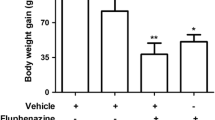Abstract
Drug-induced purposeless chewing movements in rodents are often considered to represent movement disorders or dyskinesias. We have compared the ability of drugs to induce chewing and retching or emesis in squirrel monkeys; such studies are not possible in rodents, which do not vomit. Acute administration of oxotremorine (3.3–33 µg/kg IM), SKF38393 (1–30 mg/kg SC) or ipecacuanha (0.5–0.75 mg/kg PO) caused dose-related increases in purposeless chewing which was frequently associated with retching and emesis. Treatment with haloperidol (0.015–0.06 mg/kg IM) did not induce chewing. Rather, haloperidoldecreased spontaneous chewing at doses of 0.03 and 0.06 mg/kg. Our findings indicate that at least some drug-induced oral behaviours in rodents may reflect nausea rather than dyskinesia.
Similar content being viewed by others
References
Barany S, Gunne L-M (1979) Pharmacological modification of experimental tardive dyskinesia. Acta Pharmacol Toxicol 45:107–111
Borison HL, Borison R, McCarthy LE (1981) Phylogenic and neurologic aspects of the vomiting process. J Clin Pharmacol 21:235–295
Boyce S, Rupniak NMJ, Steventon MJ, Iversen SD (1990) Differential effects of D1 and D2 agonists in MPTP-treated primates: functional implications for Parkinson's disease. Neurology 40:927–933
Braun A, Fabbrini G, Mouradian MM, Serranti C, Barone P, Chase TN (1987) Selective D-1 dopamine receptor agonist treatment of Parkinson's disease. J Neural Transm 68:41–50
Clow A, Theodorou A, Jenner P, Marsden CD (1980) Cerebral dopamine function in rats following withdrawal from one year of continuous neuroleptic administration. Eur J Pharmacol 63:145–157
Ellison G, See RE (1989) Rats administered chronic neuroleptics develop oral movements which are similar in form to those in humans with tardive dyskinesia. Psychopharmacology 98:564–566
Falardeau P, Bouchard S, Bedard PJ, Boucher R, DiPaolo T (1988) Behavioural and biochemical effects of chronic treatment with D-1 and/or D-2 dopamine agonists in MPTP monkeys. Eur J Pharmacol 150:59–66
Gerlach J, Casey D, Kistrup K (1986) D-1 and D-2 receptor manipulation in cebus monkeys: implications for extrapyramidal syndromes in humans. Clin Neuropharmacol 9:131–133
Glassman RB, Glassman HN (1980) Oral dyskinesias in braindamaged rats withdrawn from a neuroleptic: implications for models of tardive dyskinesia. Psychopharmacology 69:19–25
Grill HJ, Norgren R (1978) Chronically decerebrate rats demonstrate satiation but not bait shyness. Science 201:267–269
Gunne L-M, Barany S (1976) Haloperidol-induced tardive dyskinesia in monkeys. Psychopharmacology 50:237–240
Gunne L-M, Growdon M, Glaeser B (1982) Oral dyskinesia in rats following brain lesions and neuroleptic administration. Psychopharmacology 77:134–139
Johansson P, Levin E, Gunne L, Ellison G (1987) Opposite effects of a D1 and a D2 agonist on oral movements in rats. Eur J Pharmacol 134:83–88
Levy AD, See RE, Levin ED, Ellison GD (1987) Neuroleptic-induced oral movements in rats: methodological issues. Life Sci 41:1499–1506
Rosengarten H, Schweitzer JW, Friedholt AJ (1983) Induction of oral dyskinesias in naive rats by D1 stimulation. Life Sci 33:2479–2482
Rupniak NMJ, Jenner P, Marsden CD (1983) Cholinergic manipulation of perioral behaviour induced by chronic neuroleptic administration to rats. Psychopharmacology 79:226–230
Rupniak NMJ, Jenner P, Marsden CD (1985) Pharmacological characterisation of purposeless chewing movements in rats. Psychopharmacology 85:71–79
Rupniak NMJ, Jenner P, Marsden CD (1986) Acute dystonia induced by neuroleptic drugs. Psychopharmacology 88:403–419
Rupniak NMJ, Steventon MJ, Field MJ, Jennings CA, Iversen SD (1989) Comparison of the effects of four cholinomimetic agents on cognition in primates following disruption by scopolamine or by lists of objects. Psychopharmacology 99:189–195
Salamone JD, Lailes M, Channell SL, Iversen SD (1986) Behavioural and pharmacological characterization of the mouth movements induced by muscarinic agonists in the rat. Psychopharmacology 88:467–471
See RE, Levin ED, Ellison GD (1988) Characteristics of oral movements in rats during and after chronic haloperidol and fluphenazine administration. Psychopharmacology 94:421–427
Thal L, Fuld PA (1983) Memory enhancement with oral physostigmine in Alzheimer's disease. N Engl J Med 308:720
Waddington JL, Gamble SJ (1980) Emergence of apomorphine-induced ‘vacuous chewing’ during 6 months continuous treatment with fluphenazine decanoate. Eur J Pharmacol 68:387–388
Waddington JL, Molloy AG (1987) The status of late-onset vacuous chewing/perioral movements during long-term neuroleptic treatment in rodents: tardive dyskinesia or dystonia? Psychopharmacology 91:136–137
Author information
Authors and Affiliations
Rights and permissions
About this article
Cite this article
Rupniak, N.M.J., Tye, S.J. & Iversen, S.D. Drug-induced purposeless chewing: animal model of dyskinesia or nausea?. Psychopharmacology 102, 325–328 (1990). https://doi.org/10.1007/BF02244098
Received:
Revised:
Issue Date:
DOI: https://doi.org/10.1007/BF02244098




